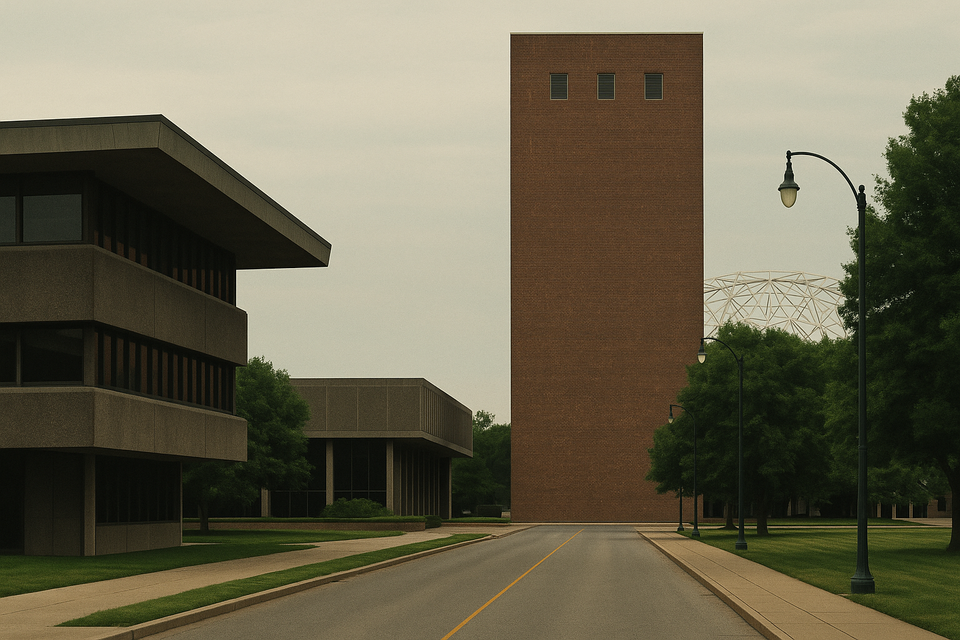Columbus (2017) — Stillness, Distance, and the Spaces Between

Spoilers for Columbus (2017) abound below.
Columbus (2017) begins with a collapse we don’t see. In a long shot heavy with negative space, Jin’s father falls somewhere off-frame, and the only movement comes from an assistant running toward him. It’s less an event than a quiet dislocation — a body suddenly absent, a center removed. From that moment, the film lives in spaces where absence speaks louder than presence. Kogonada’s framing holds his characters at a distance, letting us sense the loneliness they keep tucked away, the private rooms they never quite invite us into.
Casey, a young woman in Columbus, Indiana, talks with a friend about her uncertain future — an MLS degree, perhaps — but the conversation turns toward what she doesn’t want, what she’s not. Jin arrives from far away, summoned by his father’s collapse, yet reluctant to step too close to a man who was more a distant figure than a parent. Eleanor, his father’s assistant, is more emotionally tethered to the elder scholar than Jin ever was. From the start, the film sketches two people shaped, and in some ways stalled, by parental gravity — one held too close, the other kept too far.
Their first meeting happens outside the library, with a fence literally dividing them. She questions him from one side; he returns the gesture, and together they move toward a gate. It might be nothing, but the moment feels like the smallest opening. Soon after, Jin slips into his father’s closet at the inn, finding a hat and placing it on a suit hook as though animating a ghost. A camera rests nearby — an old Leica, perhaps — another object heavy with someone else’s gaze. Jin remarks that growing up around something makes it feel like nothing, an early sign of how familiarity can dull wonder.
The conversations between Casey and Jin are cautious at first, but he pushes her in ways others haven’t. “I’m interested in what moves you,” he says. She begins to tell him, but we hear only silence and music, her hands shaping the air. The truth of her response belongs to her alone; we’re allowed to see connection forming but not to own it. It’s the first of several moments when the film grants intimacy to the characters but withholds it from us — an act of protection that also sharpens our attention.
One evening, she brings him to her “number three building,” the place where her love of architecture began. The memory comes from a bleak stretch of her life — her mother’s addiction, and the damaging relationships her mother brought into their home. The building calmed her. Jin listens, and then says quietly, “My dad would have loved you.” The weight of the line lands differently knowing his father was largely absent; it’s an imagined bridge between Casey and a man Jin barely knew, one that seems to ache even as it flatters. She pushes back, and the air between them shifts — long shots, few cuts, the camera giving their words room to settle. It becomes clear she’s put her life on hold for her mother, a portrait of the long cost of addiction, even in recovery.
Her mother’s absence one night suggests the edge of relapse. In another scene, Jin plays Chinese checkers alone, the hat and suit jacket occupying nearby chairs — objects standing in for people who can’t or won’t be there. On the covered bridge, Casey and Jin share an intimate talk about their parents, the stillness around them deepened by the story of a spirit roaming the same bridge. In that moment, Jin seems to step into the role of her father — not literally, but in the way he listens, questions, and holds her gaze. The closeness is too much; she rebels, and he leaves her sitting there.
Elsewhere, Jin recalls being eighteen and confessing his love to Eleanor — a scene framed in the reflection of a bathroom mirror. The intimacy of the space makes the rejection sharper: “No.” “Please.” “No.” In Casey’s life, a breaking point comes when she finds her mother not at work, the unspoken implication heavier than any confrontation.
There are brief flashes of release: dancing in car headlights, visiting her high school, spending the night at Jin’s hotel. Later, Jin confesses, “He never paused his life for me,” a line that makes sense only when you realize his father’s absence was not just physical but deliberate — a decision to keep moving without him. One afternoon, standing with Casey, he looks up and decides — or chooses to believe — that the “brick walls in the sky” were what his father had been referencing in his cryptic notes. “Or not,” he says, but the caveat doesn’t blunt the gesture. It’s less about being certain than about having something, however small, that he can claim they share. By deciding it mattered to them both, Jin builds a connection that wasn’t handed to him — one he’s had to construct for himself, like a private bridge across years of absence.
In the film’s final movements, Casey makes her decision — quietly, without a speech or a scene of packing. The implication is that she will go with Eleanor to Chicago, stepping away from the stalled rhythms of her life with her mother. It’s not a grand reinvention, but a shift in direction, the kind of choice that may not look like much from the outside but feels seismic from within.
Jin, by contrast, chooses to stay. He rents an apartment month-to-month, keeping himself in his father’s orbit even as Casey leaves hers. His is a decision rooted not in resolution but in a willingness, perhaps for the first time, to linger in the same space as the man who shaped him by absence. Both choices carry their own risks — one in leaving, one in staying — and the film lets them sit side by side without ranking them.
When they part, the camera returns to the spaces they once inhabited together: the bench, the bridge, the hotel room. Now they’re empty, and the emptiness is the point. Columbus is a film about how people live inside spaces, and how spaces hold the echo of the people who’ve left them. Its sadness isn’t the kind that demands pity; it’s the sadness of recognizing that not every connection can be kept, even when it matters.
It is, in its quiet way, deeply moving. The stillness is not a void but a container — for unspoken truths, for the weight of family, for the delicate architectures we build with one another. By the end, nothing is wrapped up, but something has shifted. Casey walks away, Jin stays behind, and both carry the imprint of the other. It’s terribly sad, but in a way that lingers like a building you pass once and can’t forget, even if you never go inside.



Comments ()